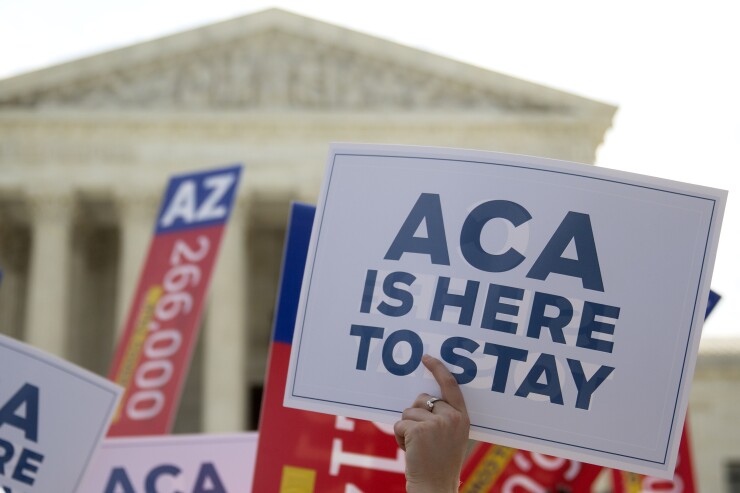For tax preparers and taxpayers still confused by the complexities of Affordable Care Act reporting from the past filing season, it’s still around to make life complicated in the season ahead. Barring a last-minute repeal in tax reform or end-of-year legislation, it’s still the law.
“My guess is they won’t repeal the individual mandate,” said Dustin Stamper, director in Grant Thornton’s Washington National Tax Office. “If they did, it would create problems for the exchanges. ... Since ‘repeal and replace’ couldn’t get done, the Republicans would own health care and would share in the blame if anything disastrous happened to the exchanges.”
“For nearly four years, legislation was challenged and revised, deadlines were postponed, state and federal hearings were held, the Supreme Court pronounced it legitimate, Medicare Part D was revised, dependent coverage and pre-existing conditions were clarified, contraception provisions were written, state and federal exchanges were created, federal subsidies were put into place, and Web sites, FAQs and guides were designed,” said Annie Schwab, tax manager at Padgett Business Services. “And we still have it.”
“The Qualified Small Employer Health Reimbursement Arrangements, or QSEHRAs, are new for 2017,” she said. “This allows small employers that don’t offer group health plans to reimburse employees for qualified medical expenses, including premiums for health insurance policies, without incurring a penalty. To qualify, the employer must be a small employer with 50 or fewer employees; the employer does not offer a group health plan; and the employee has minimum essential coverage through a different source. Those that qualify must specify the amount on the employee’s W-2.”
The sound of silents
Filing season issues left over from the past season include the acceptance of “silent returns,” according to Schwab.
A silent return is one where the box is not checked indicating an individual’s full-year coverage, or one that does not include Forms 8965 or 8962 indicating that an exemption applies or that a premium tax credit was reconciled or a penalty payment was made. Initially, the IRS said that it would not accept those returns, but reversed itself in February 2017, stating that it would accept them. Now, however, the IRS has reversed itself again, stating that it will enforce the reporting requirements for 2018 filing of 2017 returns.
“The IRS will not accept the electronic tax return until the taxpayer indicates whether they had coverage, had an exemption, or will make a shared responsibility payment. In addition, returns filed on paper that do not address the health coverage requirements may be suspended pending the receipt of additional information and any refunds may be delayed,” the agency stated.
“This means that each individual must have minimum essential health care coverage or qualify for an exemption or pay a penalty —an individual shared responsibility payment,” said Janice Krueger, subject matter expert at Greatland Corp. “And employers with at least 50 full-time employees, including full-time equivalents, must offer affordable minimum essential coverage.”
“Despite all the activity in the last 10 months, including an executive order and several IRS information letters, ACA reporting is still required and taxpayers remain required to follow the law and pay what they may owe,” she observed.
“Form 1095-A must be filed by health insurance companies to report coverage information for individuals who purchased insurance through the marketplace and to reconcile any advance payment of the premium tax credit,” Krueger noted. “Form 1095-B must be filed by health insurance carriers or issuers, plan sponsors of self-insured groups, and a government agency that provides coverage under a government plan.”
“The purpose of Form 1095-C is to help employees determine whether they can claim a premium tax credit and to assist the IRS in determining whether the employer owes an employer shared responsibility payment,” she said.

The following deadlines are in effect for 2017 returns, Krueger said: Form 1095 copies must be furnished to employees by Jan. 31, 2018; paper copies of the 1095 must be sent to the IRS by Feb. 28, 2018; and, if e-filed, Form 1095 must be filed by April 2, 2018.
Previous problems
Krueger noted areas of confusion based on the filing of Form 1095-C this past season. “Form 1095-C applies to all applicable large employers, including for-profit, nonprofit and government entity employers,” she said. “If two or more companies have a common owner or are otherwise related, they are combined for purposes of determining whether they employ enough employees to be considered an ALE. For example, if two companies, one with 30 full-time equivalents and the other with 40 full-time equivalents have a common owner, the full-time equivalents are combined to determine if each separate company is an ALE. If the combined total meets the 50 FTE threshold, then each separate company is considered an ALE.”
“If an ALE does not offer coverage, the ALE is still required to file Form 1095-C,” she cautioned. “And despite the fact that an employee waives coverage from an ALE, the ALE needs to file Form 1095-C for the employee.”
For individuals, certain exemptions are granted by the marketplace, while others are claimed on the individual tax return, Schwab noted. “Hardship exemptions may only be granted by the marketplace,” she said. “A nine-digit code per exemption per taxpayer household is obtained by applying online at





